I think you will agree starting a membership blog seems daunting, especially for a first-timer.
Talk to just about any beginner who has never created a membership blog (or even a simple website), and they will field questions such as:
- Why should I start a membership blog?
- What kind of content, products, or services should I offer?
- Which membership blog platform should I use?
- Can you even make good money with a membership website?
- How long does it take to create a successful membership site?
- Who is my target audience?
- How much does it cost to run a membership website?
- And the list goes on.
Even if you finally get the whole thing up and running, you still need to keep oiling multiple cogs to keep your membership blog in tip-top condition.
For instance, you need to improve or add to your premium content regularly to increase the value of your site. This might be a challenge, especially if you’re already struggling with content creation.
Also, you must invest lots of effort to attract new visitors and convert them into paying members. This means either sharpening your conversion optimization skills or hiring an expert.
In addition, you’ll need to employ all user retention tactics in your membership marketing arsenal to keep members subscribed for as long as possible.
These are some of the questions and challenges that discourage many would-be entrepreneurs from starting membership blogs.
If you are in a similar situation, you are not alone. We wrote the following article to help you create a profitable membership blog you’re proud of.
Many have done it before you, as you will learn later in the article.
Like any worthwhile endeavor, it will take some effort, money, time, grit, and a bucketful of patience to create a wildly successful membership blog.
Let’s start!
What is a Membership Blog?
A membership blog is a type of website that offers what is commonly known as gated or member-only content.
To the uninitiated, gated content is any material locked behind a membership login.
Users must become members for free or at a fee to access said content and other membership perks.
Most membership blogs offer tons of free content and other incentives to coax users to join the membership.
Other membership sites offer premium content only, meaning you must pay before gaining access.
Typically, membership sites thrive on recurring payments. Users can pay weekly, monthly, or annually, although you can adopt any payment schedule that works for your business.
That said, membership blogs take many different forms.
Popular models include:
- Paywall – Here, you offer premium content behind a paywall. Users must pay to gain access. Popular news websites such as The New York Times and HuffPost use the paywall model successfully;
- Courses – This is probably the most popular application of membership blogs. Over the years, I have seen many people grow small blogs into rich membership sites that rake millions. My favorite examples are Smart Blogger and Copyblogger Academy;
- Products – Who knew membership sites are brilliant avenues to sell digital and physical products? Take Dollar Shave Club, for instance. They send you razor blades and shaving supplies for a monthly subscription. Another example is CodeLobster, which uses the model to sell IDE software to developers. We also use the membership model for Paid Member Subscriptions;
- Online Communities – An online community is the model you want to adopt if your members interact with each other actively. Many companies, like Microsoft and McDonald’s, use online communities to boost user engagement, enhance member retention, and offer better support.
No matter the model you choose, your main goal should be to provide massive value people are willing to pay for.
Besides, you have nothing to lose. When done right, membership blogs are highly profitable. Also, you can expect significant growth in market size in the coming years.
Main Takeaway: A membership blog is a website that allows people to access your premium content after subscribing (creating a member account). You can offer free memberships or charge users to access your content. Different membership models succeed with subscriptions (or recurring payments).
Why Are Membership Blogs Growing in Popularity?

So why is everybody pining for membership websites? Recent data shows the subscription model is growing in popularity and revenue across different industries.
Here are some reasons why.
Challenges in Traditional Advertising and Monetization
Hand up if you know Forbes. I have visited the website many times and enjoyed its content.
But hear this:
I have the latest version of AdBlock installed. And these good folks have blocked more than 5K unwanted and intrusive ads as of this sitting.

Back to Forbes.
While researching, I followed a link to an interesting article on Forbes.
After a few seconds on the website, they asked me to disable AdBlock because advertising revenue keeps their lights on.
Long story short, I disabled AdBlock, and that one Forbes tab froze like Olaf in Frozen. I had to restart Chrome.
Was I happy with Forbes after the unbearable ad circus? Nope. Would buying a subscription to enjoy ad-free content make more sense to me? Yes, sir, take my money.
Lots of internet folks will back me on this; many are the people who hate ads. Plus – if you didn’t know – consumers have developed psychological phenomena known as “ad fatigue” and “banner blindness.”
As more consumers block these unwanted ads, businesses that rely on advertising must adopt alternative monetization strategies to keep up with revenue goals.
And guess what?
A membership blog offers just the monetization opportunities you need.
Aside: Forbes uses, among other monetization strategies, subscriptions to generate revenue. For this reason, they qualify as an exemplary example of a membership blog in action.
Growth in Demand for Ad-Free and Personalized Content
Pivoting from our previous point, it’s no secret that more people are dying for uninterrupted experiences.
The situation gets worse, especially when they have unlimited sources of the same content online.
For this reason, more consumers are willing to pay for ad-free content, which is where your membership blog comes in.
Instead of using ads that turn off your visitors, you can align with the growing demand for ad-free experiences to grow your business further.
It is no wonder The New York Times makes a tidy sum from over 10 million subscribers with the paywall model.
Ad-free experiences aside, many people are now used to personalized content. If you are like me, you want content that speaks to your interests and preferences.
The membership model lets you create member-centric content that aligns with individual preferences.
Why is personalization important?
It leads to more engaging and relevant customer experiences, which – as you’d expect – almost always leads to more revenue.
Another point. The modern-day consumer is more cautious of data privacy and security issues.
But…
Advertisers are notorious for data mining, which poses privacy concerns for many internet users.
A membership site allows you to create a premium, ad-free, and safe environment for subscribers.
Growth of Subscription Commerce
Unless you live under a rock, you must know that more people are abandoning generic mass media content in favor of tailored, personalized content.
This shift in consumer behavior has given birth to subscription commerce. In other words, more consumers are interested in “access” instead of “ownership.”
This is what I mean.
Why buy a DVD for about thirty bucks when you can watch loads of content on Hulu or Netflix for about $7 a month?
I will wager that Amazon Prime, Hulu, and Netflix aren’t your only subscriptions. You’re hooked to multiple memberships like most of us.
You probably get your blades from Dollar Shave Club. And your groceries from HelloFresh. Other famous subscription models include Birchbox and BarkBox.
Aren’t these companies exciting examples of membership sites?
Let’s move on.
As the astute entrepreneur you are, understand this paradigm shift and capitalize by offering bundle offerings.
Consumers, too, are drinking the Kool-Aid.
The vast majority of the populace is embracing subscription stacking.
That means most people are actively interested in bundled subscriptions, which are easy to offer on your membership blog.
Oh, lest I forget, Netflix and Hulu are fantastic examples of content personalization in practice.
Aside: The subscription commerce model isn’t limited to digital subscriptions. At the moment, it extends to physical products and services. For fabulous examples, check out this article: 15 Killer Membership Site Ideas to Spark Your Imagination in 2023 and beyond.
Main Takeaway: The subscription model (along with membership sites) is growing in popularity and market size. Factors fueling this growth include challenges in traditional advertising, demand for ad-free and personalized content, and growth of subscription commerce, among others.
Benefits of a Membership Blog

Are you wondering why you should start a membership blog? Membership blogs offer several benefits to both creators and members.
Here are some solid reasons why you should create a membership blog today.
Sustainable & Predictable Income
One of the main benefits of a membership blog is steady and predictable income. Memberships rely on recurring subscription fees, among other monetization strategies.
The good thing about recurring payments is you can predict how much you will make at the end of every billing cycle.
Besides, recurring payments are more dependable than fluctuating advertising revenue or one-time transactions.
Additionally, you can easily monetize your expertise and knowledge. You can offer specialized content to a target audience genuinely interested in the subject matter.
I have seen coaches offer writing courses for as high as $5,000! I’m not even kidding. That’s what Smart Blogger does. Another good example is Urth Clay Studio, which uses the membership model to offer pottery classes.
Moreover, a membership blog allows you to diversify your income streams. For instance, on top of selling your premium content, you can add merchandise, in-person consultation, speaking gigs, and affiliate marketing to the mix to create a dependable income portfolio.
Having sustainable and predictable income gives you peace of mind and room for proper budgeting, which lets you plan for long-term growth.
Building an Engaged Community
Membership blogs help you to create more than just transactional relationships with your audience.
Firstly, you have a direct line of communication with your tribe. A membership blog allows you to engage with your users actively. This lets you understand their needs deeply and respond with solutions in real-time.
Second, members can actively participate in activities and discussions because they feel a sense of belonging. After all, they share common interests and are paying for membership.
An engaged community is an asset for your business. With the right marketing tactics, such as email marketing, you can make money from your audience year after year.
But it is not all about the money. Right? Creating an engaged community means you have the penultimate chance to change many lives at once.
That said, a membership blog helps you to understand your audience better. This allows you to create personalized and tailored content that lets you engineer a more engaging and relevant experience.
In addition, membership blogs usually have interactive features such as forums, quizzes, live Q&A sessions, member-only events, and gamification.
These features boost community engagement, which can help you turn your membership site into more than a content subscription.
Moreover, interacting with your members directly creates a continuous feedback loop, allowing you to create valuable content relevant to your customers.
Creating a Membership Blog is Easier Than You Think
Anybody who tells you starting a membership blog is hard is taking you for a ride and probably trying to arm-wrestle you into a deal of some sort.
Many platforms allow you to start a membership blog quickly without breaking the bank. I recommend going the WordPress.org route because it’s cheap and easy to customize.
You can have a membership website up and running in no time using a plugin such as Paid Member Subscriptions.
There is a powerful free version, but you can always spring for the pro version for more features. Later, I will show you how to use the plugin to start a fully functional membership site.
With Paid Member Subscriptions powering your membership blog, you only need to focus on creating your content and products.
Other platforms that support memberships include Patreon, Medium, The Skimm, and Substack, among others. Still, I recommend WordPress.org since it offers you flexibility and total control over your content.
The bottom line is membership blogs are easy to launch. You don’t require advanced technical skills to start.
If you choose WordPress, you will invest in a domain name, web hosting, and – most likely – a premium membership theme. The Total multipurpose theme is a fabulous place to start.
For holiday discounts and deals on domains and hosting, check out Namecheap and Dreamhost.
Flexibility in Content Creation
If you overly rely on advertising revenue, you depend on ad metrics and specific content types to keep making money.
The membership blog model offers you a lot of flexibility in content creation. You can experiment with different formats, styles, and topics.
In other words, you’re not constrained by traditional ad metrics. You can use different storytelling techniques and other innovative ways.
In addition, you can quickly adapt to changing trends and tailor content to member preferences.
Besides using diverse content formats, you can experiment with varying content frequencies to deliver content that keeps members engaged.
On top of that, you can explore seasonal or themed content to offer exciting content that boosts engagement around your membership blog.
In the same light, you can use interactive elements and respond to user feedback promptly. Further, you can leverage collaborations and guest contributions to increase the value of your membership. I’m sure you have seen many people using podcasts and webinars to boost membership.
These are just a few benefits of starting a membership blog. Others include:
- Exclusivity and loyalty;
- Privacy and user control;
- Reduced reliance on advertising.
Main Takeaway: Membership blogs have many sweet benefits. That’s not a secret. The membership model doesn’t have notable drawbacks. I can’t think of any outstanding con other than the fact you must invest in content creation beforehand. But that isn’t exactly a drawback. It’s just part of the job.
Next, we highlight a few popular membership blogs to show how the model works in the real world.
Success Stories: 5 Popular Membership Blogs
Perhaps you’re a bit skeptical. Maybe a membership website isn’t worth your time and effort. Nothing could be further from the truth.
Seeing is believing. Right?
Many people (beginners and pros alike) have created massively successful membership blogs. There are so many examples that I must stick with a few. Besides, we’ve peppered this article with lots of examples. Here are a few more.
Location Rebel

Formerly known as Location 180, visit this membership blog to learn lots about online business and how to make money writing,
I have learned a lot from Sean Ogle, so I wouldn’t doubt his courses if I were you.
The Location Rebel Academy teaches you everything from lifestyle business to freelance writing, SEO, and more for $749. (Or $149/month for six months).
With more than 4k members, it’s appropriate to say it’s a great, tight-knit community for online entrepreneurs.
Don’t have the budget yet? You can still enjoy Sean’s free articles and emails. The team at LRA will even teach you how to write the perfect pitch. The course is a collaboration project featuring several different creators.
Authority Hacker

Are you looking to create a successful website? If that’s a resounding yes, Authority Hacker is where you want to go.
Mark and Gael have been in the business of building niche authority sites for over 20 years. That goes to say you can learn a lot from these guys.
They offer free training, but if you need to fast-track your results, I can’t recommend their premium courses enough.
Authority Hacker courses cover many topics, including market research, keyword research, website design, content creation, link building, monetization, and more.
Their most popular course, The Authority Site System, costs $330/month for six months.
Membership Geeks

If you’re looking to start a membership blog, you need all the help you can get. For a beginner, there is a lot to learn.
Membership Geeks (previously The Membership Guys) offers everything you need to plan, build, and launch a successful membership site.
With the Membership Academy, Mike Morrison and Callie Willows have helped more than 7,000 entrepreneurs launch 6, 7, and even 8-figure membership sites in diverse industries.
With more than 20 years of experience, the pair know what they are doing. Their shining testimonials are also enough proof you’re in safe hands.
Membership Geeks offers two plans: Academy Standard at $39/month and Academy Pro at $65/month.
Melyssa Griffin

Melyssa Griffin is a force of nature, and you can feel lots of energy and positive vibes the moment you land on her membership website.
If you feel stuck in life and think your mindset is holding you back from the success you deserve, you should check out Melyssa’s material.
A former teacher who turned into an online entrepreneur, Melyssa offers tons of free and premium content to help you overcome limiting beliefs and build the life you’ve always dreamed of.
She teaches over 20k students to own Pinterest, email marketing, and content creation like a boss. And why should you bother following Melyssa Her membership blog has made over $10 million.
Melyssa offers several courses, a podcast, and a mastermind group. Her courses begin at $97/month for six months.
Nomadic Matt

Are you an enthusiastic traveler? If you cannot wait to hop on the next flight out of town, you will feel right at home on the Nomadic Matt website.
This membership blog contains plenty of traveling advice and tips from Matt’s numerous trips.
Matt has been traversing the globe since 2006, meaning you can learn a lot from his travel experiences. Also, he is a renowned travel writer.
The Nomadic Matt membership blog offers you tons of free content. If you need to learn more, you can sign up for any of his membership plans, beginning at just $79/month or $199/quarter.
All the above membership blogs make good money for their creators. The best part is most of the income is passive, and most creators said they work for about 2 hours per day.
How to Create a Membership Blog
Now that membership blogs don’t sound like an alien idea, how about we create one? We covered this topic several times, so I will keep this section short and sweet.
I will use the Paid Member Subscriptions plugin and the Astra WordPress theme to keep things simple. However, feel free to use any membership website theme you fancy.
Let’s start.
Install and Activate Paid Member Subscriptions
You must first install the free Paid Member Subscriptions for the pro version to work. Then log in to your Cozmoslabs account and download Paid Member Subscriptions.
After that, log in to your WordPress admin. Click Plugins → Add New Plugin → Upload Plugin.
Next, choose the Paid Membership Subscriptions file from your computer and hit the Install Now button.
Next, activate the plugin, which should launch the setup wizard automatically.
If it doesn’t open the wizard, you can launch it manually by navigating to Paid Member Subscriptions → Dashboard.
On the first page of the setup wizard, tick everything and click Continue, as shown below.
Next, choose your Design & User Experience settings and click Continue:
After that, configure your payment gateway and hit Continue. You can use Stripe, PayPal, or manual payments.
And you’re ready to rock and roll. Paid Member Subscriptions Pro is now installed. Before doing anything else, don’t forget to activate your license.
To do that, navigate to Paid Member Subscriptions → Settings. Paste your license key, click Activate License, and then Save Settings.
Now you’re ready for the fun part.
Add Membership Plans
The Paid Member Subscriptions plugin allows you to create free and paid subscription plans. You can offer limited access to free plans and charge a fixed or recurring fee for paid tiers.
Go to Paid Member Subscriptions → Subscriptions Plans → Add New:
Enter your subscription plan details as you deem fit. To create a free plan, set the price to zero. Once you fill in your details, click Save Subscription.
You can add more subscriptions similarly. Also, note that you can add tiered plans so that users can upgrade or downgrade at will.
To do that, head to the Subscription Plans screen, hover over any plan, and click either Add Upgrade or Add Downgrade:
This will lead you to the Edit Subscription screen, where you can add details about your upgrade or downgrade plan.
Create the Pricing Page
With your plans ready, it’s time to create a pricing page. Inside the Subscription Plans screen, click Create Pricing Page.
Next, choose the order of your plans and click Submit.

This leads you to the WordPress post editor, where you can further customize the page.
Customize Main Pages
During the setup wizard, Paid Member Subscriptions automatically create four main pages. These pages are Account, Login, Register, and Password Reset which contain their respective forms.

The pages are ready to use as they are, but you can personalize them for your site. You can customize the pages as much as you want – but don’t remove the shortcode that’s there.
To edit any page, navigate to your Pages screen and choose the one you want.

Restrict Member-Only Content
You now have working pages and subscription plans. Next, you want to restrict content that’s only available to members.
To restrict a single piece of content, open it in the editor. Scroll to the bottom and choose your settings in the Content Restriction box.
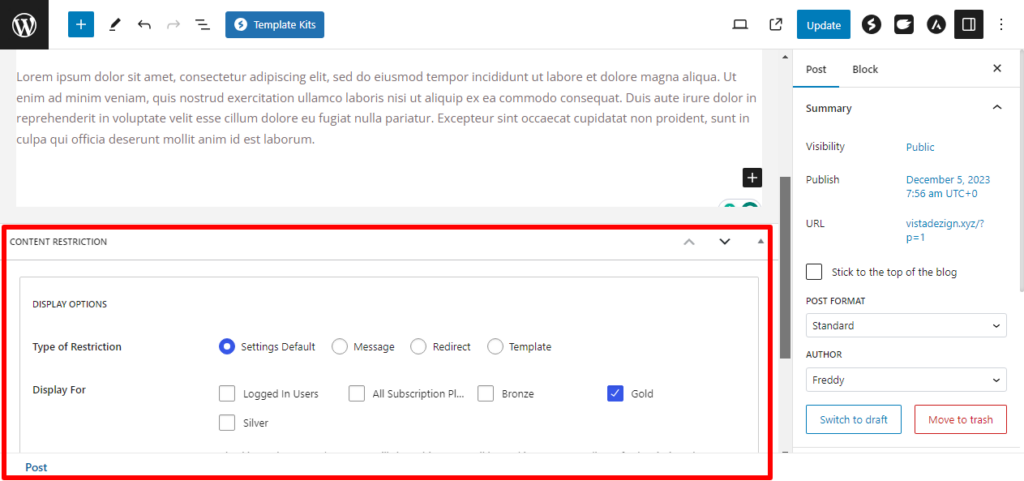
Restricting content piece by piece is time-consuming, especially if you have a ton of content on your membership blog.
To save time, you can use the Global Content Restriction add-on. To activate bulk restriction, navigate to Paid Member Subscriptions → Add-ons, and activate Global Content Restriction.
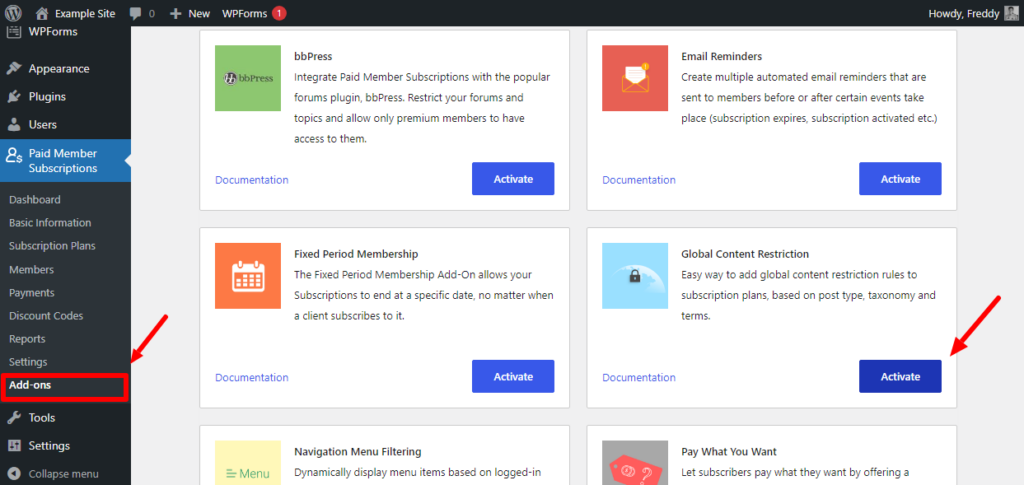
Next, go to the Subscription Plans screen and edit the plan you want to bulk restrict content for. At the bottom, you will have a new Global Content Restriction box.
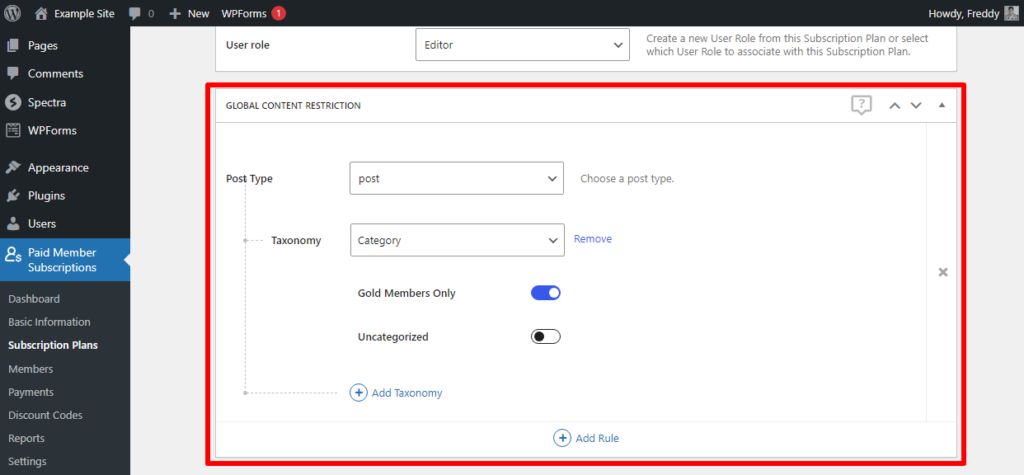
Here, you can bulk restrict all posts in a category or post type.
And that’s it! You now have a functioning membership blog. You can customize your design as you see fit. For instance, this is how my final test site looks.

If I click on the Pricing menu item, as shown above, I land on the following page.
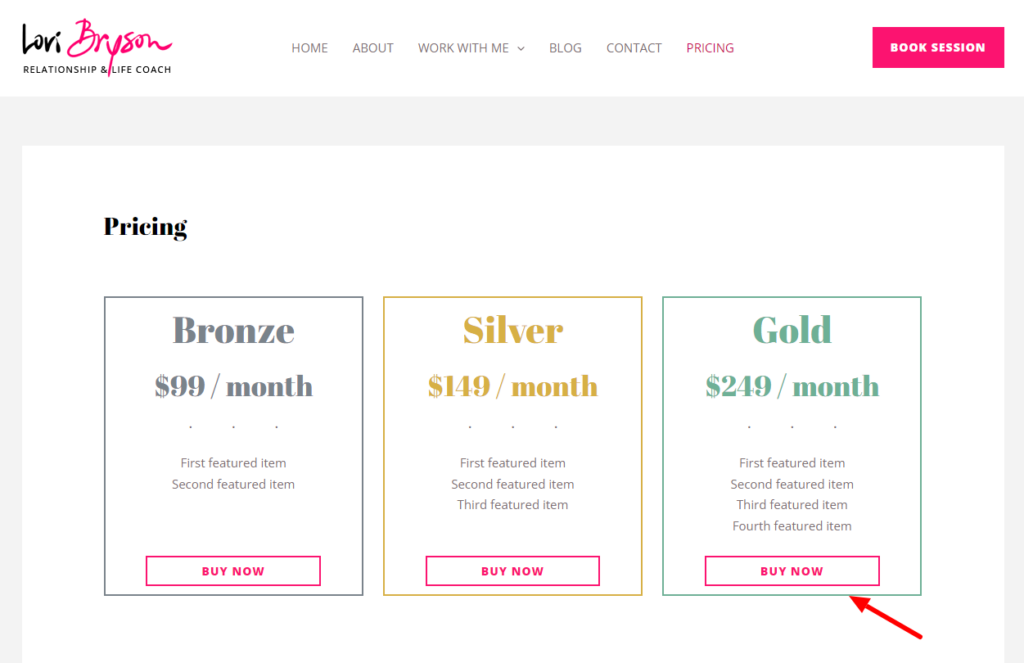
When I buy any plan, I’m taken to the registration page.
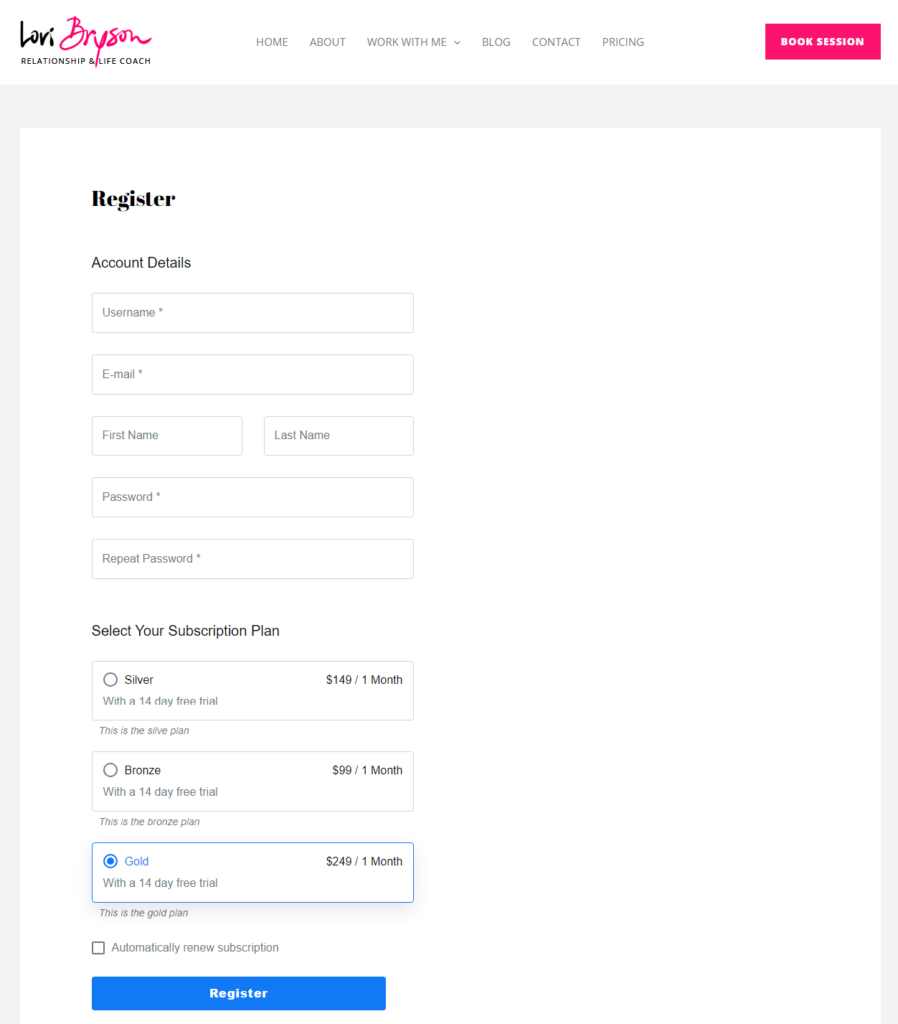
You can customize your website design and the content of all pages as you see fit.
Paid Member Subscriptions Pro
Paid Member Subscriptions offers you all the tools you need to start a membership blog without breaking a sweat.
Conclusion
A membership blog is a fantastic business model for beginners and experts. It offers you a sustainable and predictable source of income and allows you to create an engaged community around your brand.
It’s easy to create, especially with a membership plugin such as Paid Member Subscriptions. What are your thoughts? Let us know in the comments!
Source: https://www.cozmoslabs.com/2418001-start-a-membership-blog/

